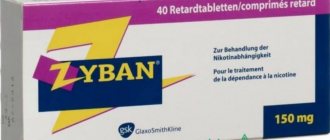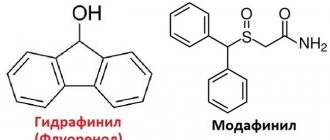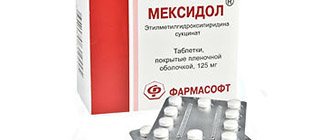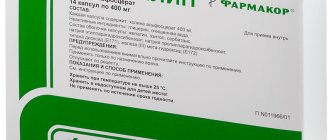Side effects of Buspirone
From the nervous system and sensory organs:
dizziness (12%), drowsiness (10%), headache (6%), nervousness (5%), fatigue (4%), sleep disturbance (3%), decreased ability to concentrate (2%); extrapyramidal disorders (very rare); ≤2% - blurred vision, confusion or depression, weakness, numbness; ≤1% - neurological symptoms (muscle weakness, tingling, pain or weakness in the arms or legs, uncontrolled movements of the torso).
From the cardiovascular system and blood (hematopoiesis, hemostasis):
≤1% - tachycardia/palpitations.
From the gastrointestinal tract:
nausea (8%), dry mouth (3%), diarrhea (2%); ≤1% - vomiting, constipation; decreased appetite.
Other:
≤1% - myalgia, spasms, muscle cramps or stiffness, rash, sweating.
Spitomin (buspirone). A new “classic” in the treatment of anxiety disorders
Introduction to the problem
According to large-scale epidemiological studies conducted in the United States and European countries in 2005 and 2010, anxiety disorders of varying severity are observed in 21-30% of the population1.
According to WHO, the problem is among the top 10 most significant health problems2. It has been proven that anxiety disorders are characterized by a chronic course3 and a high degree of comorbidity with other mental and behavioral disorders. First of all, this concerns depression, which in more than 50% of cases4 accompanies panic disorder or generalized anxiety disorder. Often, the combination of anxiety and depressive disorders leads to a more severe course of the disease and resistance to standard treatment.
Treatment of anxiety and depressive disorders, which include generalized anxiety disorder (GAD), panic disorder with agoraphobia, post-traumatic stress disorder (PTSD), obsessive-compulsive disorder (OCD), social phobias, usually long-term and combined, requires careful selection of doses , their episodic correction and monitoring of side effects.
Complex therapy should be aimed at:
- elimination of mental and somatic symptoms (anxiety, restlessness, muscle tension, sleep disorders, pain, blood pressure fluctuations, arrhythmias, etc.),
- treatment of comorbid conditions,
- improving quality of life,
- achieving complete remission (preventing relapses).
Among the means of pharmacotherapy today, combinations of tricyclic antidepressants, antidepressants of the SSRI and SNRI groups, and benzodiazepines are most often used.
Current problems in classical treatment of anxiety disorders
Antidepressants
The therapeutic effect of SSRIs, like other antidepressants, is realized mainly from the 2-3rd week of therapy, and the 1st week may be marked by increased anxiety, which is subjectively difficult for patients to tolerate5. In addition, there is the possibility of developing, despite a generally favorable tolerability profile, potentially dangerous side effects (serotonin syndrome), as well as withdrawal syndrome6.
Benzodiazepines
It is a generally accepted fact that tranquilizers of this group have pronounced undesirable effects: muscle relaxant, sedative, excessive hypnotic, amnestic, negative effects on psychomotor functions, a high risk of developing addiction and withdrawal syndrome7.
Pregabalin
Recently, the psychotropic activity of the drug pregabalin, a structural analogue of GABA, has been discussed in the literature. It reduces the stimulation of postsynaptic neurons, causing anxiolytic, anticonvulsant and analgesic effects. However, when using the drug for 8 weeks, only 52% of patients showed a 50% reduction in symptoms on the Hamilton Anxiety Scale (HAM-A)8.
Taking into account the goals of therapy and existing problems, a list of requirements was determined that the main clinical and pharmacological characteristics of anxiolytics must meet:
- a distinct anxiolytic effect, both in relation to the mental and somatic components of anxiety;
- lack of sedative, muscle relaxant and additive properties;
- the effect of the drug should be aimed not only at eliminating the mental symptoms of the disorder, but also at treating comorbid conditions;
- reduction of maladjustment;
- improving quality of life.
The drug Spitomin (buspirone), the only representative of the class of serotonergic anxiolytics, azapirones, perhaps best meets these criteria.
Spitomin (buspirone): mechanism of action
Buspirone differs in its chemical structure from all other previously known anxiolytics and belongs to the azaspirone class.
Its anxiolytic effect is associated with stimulation of presynaptic serotonin autoreceptors, and, unlike SSRIs, does not depend on the nature of the basal release of serotonin9. Buspirone has proven to be an effective pharmacotherapy for the most difficult to treat forms of anxiety disorders, and was the first non-benzodiazepine anxiolytic approved by the FDA in 1986 for the treatment of patients with GAD10.
Spitomin (buspirone) occupies a special place among all neuropharmacological agents and can be considered as a drug that combines the properties of an anxiolytic and antidepressant, which is of great value in the treatment of mixed anxiety-depressive disorders.
Spitomin (buspirone) affects:
- Serotonin neuromediation system. When it is hyperactive, it stimulates presynaptic 5-HT1A receptors, which block the release of serotonin into the synapse (antiserotonergic effect). When it is weakened, it stimulates postsynaptic 5-HT1A receptors (activates serotonergic processes)11.
- Dopamine neurotransmission system. By selectively blocking pre- and post-synaptic D2 receptors, it increases the rate of excitation of midbrain dopamine neurons12 and enhances its independent antidepressant effect.
- Norepinephrine neuromediation system. Active metabolites of buspirone have adrenergic effects13. The associated general uplift in mood explains the antidepressant effect in patients resistant to SSRIs.
Spitomin (buspirone) does not affect either GABA or benzodiazepine receptors, and therefore does not have the side effects of such tranquilizers. However, in terms of its effectiveness by 7-14 days of therapy, the drug is comparable to typical benzodiazepines.
Indications for use
Spitomin (buspirone) has shown its clinical effectiveness in the treatment of the following diseases:
- Generalized anxiety disorder (GAD).
- Panic disorder.
- Autonomic dysfunction syndrome.
- Alcohol withdrawal syndrome (as an auxiliary therapy).
- Depressive disorders (as an auxiliary therapy).
Clinical effectiveness
Based on numerous clinical studies (Murphy, Owen and Tyrer; Schramm et al., Pato et al., Goodman et al., Jenike et al., Robinson et al. et al.), buspirone has been proven to be a very promising and safe treatment for long-term mono- or combination therapy.
For generalized anxiety disorder
The anxiolytic effect of buspirone does not differ from that of diazepam (after use for 3 or more weeks)14. Buspirone is much more effective than benzodiazepines in reducing depressive symptoms associated with anxiety disorder. Adverse effects of sedation with buspirone occur much less frequently than with benzodiazepines15.
For anxiety and depression
The effectiveness of buspirone in the treatment of GAD in combination with depressive symptoms is 1.3 times greater than placebo in reducing anxiety and 1.6 times greater than placebo in reducing depressive symptoms16. Tolerability of buspirone is comparable to placebo.
For obsessive-compulsive disorder (OCD)
- Clomipramine and buspirone show similar results on the OCD scale and the depression scale.
- Buspirone added to fluoxetine therapy for OCD increases the effectiveness of treatment.
- The simultaneous use of buspirone and antipsychotics is well suited for patients who are not amenable to therapy with selective serotonin reuptake inhibitors.
When treating depression
Numerous open studies have clearly demonstrated the positive effect of buspirone on depressive symptoms, including resistant depression. When buspirone was added to antidepressant therapy, there was a significant improvement in the condition compared with the placebo group. Some symptoms, such as depressed mood, reluctance to work, and lethargy, decreased after the first week of taking the drug.
Buspirone, already an effective antidepressant in itself, when added to enhance treatment with classical antidepressants, presumably through the serotonergic and noradrenergic systems, can improve treatment outcomes17. Buspirone is an effective and safe drug for improving the results of antidepressant therapy.
In the treatment of panic disorder
Buspirone significantly reduces the severity of generalized anxiety, agoraphobia, panic attacks and depression in the short term18. The positive effects of buspirone have been demonstrated on both the cognitive and somatic components of anxiety.
For anxiety disorder in elderly patients
Use of buspirone in older adults with anxiety disorders is more beneficial than treatment with benzodiazepines. Often, when treating such patients, a long-lasting anxiolytic effect is achieved while maintaining muscle tone, normal breathing, and the speed of cognitive and psychomotor reactions. In addition, it is important that buspirone improves mood.
For alcohol addiction
In the buspirone group, compared with placebo, there was a significant improvement in the following psychopathology measures: anxiety disorder, depression, irritability, interpersonal relationships, and global psychopathology score. A meta-analysis showed that buspirone improves the effectiveness of treatment for alcohol dependence and anxiety disorders. The researchers concluded that the main effect of buspirone in patients with alcohol dependence is not a reduction in alcohol consumption, but a positive effect on psychopathological symptoms. It improves mood, which is very important in the treatment of anxiety disorders, does not cause addiction, and does not have a negative effect on the psychomotor reaction.
Conclusion
Thus, Spitomin (buspirone) can successfully replace classical drugs that cause intolerance or side effects, or complement therapy to achieve a more complete and rapid effect.
Buspirone is a powerful serotonergic selective anxiolytic, which, due to its pharmacodynamics, has a pronounced anxiolytic effect without impairing cognitive functions and the speed of psychomotor reactions, ideal for both elderly and active business people.
1 Kessler RC, Chiu WT, Demler O et al. Prevalence, severity and comorbidity of 12-month DSM-IV disorders in NCSR. Arch Gen Psychiatr 2005; 62: 617–27; Terrie E, HonaLee H, Avshalom C et al. Depression and generalized anxiety disorder: cumulative and sequential comorbidity in a Birth cohort followed prospectively to age 32 years. Arch Gen Psychiatry 2007;
2 Barlow DH. Anxiety and its disorders: the nature and treatment of anxiety and panic. NY: Guilford Press 2002; European Status Report on Alcohol and Health 2010. WHO Euro, Copenhagen;
3 Hirschfeld RM. Placebo response in the treatment of panic disorder. Bull Manning Clin 1996; 60 (2): 76–86;. Keller MB. The clinical course of panic disorder and depression. J Clin Psychiat 1992; 53(Suppl.): 5–8;
4 Kalinin VV / Anxiety disorders – Rijeka: In Tech, 2011 – 323p;
5 Nutt DJ. Overview of diagnosis and drug treatments of anxiety disorders. CNS Spectr 2005; 10 (1): 49–56;
6 Schatzberg AF, Haddad P, Kaplan EM et al. Serotonin reuptake inhibitor discontinuation syndrome: a hypothetical definition. Discontinuation consensus panel. J Clin Psychiat 1997; 58(Suppl. 7): 5–10;
7 Avedisova A.S., Yastrebov D.V., Kostacheva E.A. and others. Pharmacoepidemiological analysis of outpatient prescription of benzodiazepine tranquilizers in psychiatric institutions. Ross. Psychiatrist. magazine 2005; 4: 10–2;
8 Instructions for use of pregabalin (Lyrica).
9 Baldwin D, I Anderson, D Nutt et al. Evidence-based guidelines for the pharmacological treatment of anxiety disorders: recommendations from the British Association for Psychopharmacology. J Psychopharmacol 2005; 19:567–96
10 Loane C, Politis M. Buspirone: what is it all about? Brain Res. 2012 Jun 21; 1461: 111-8
11 Anon A. Buspiron bei Angst und Depression // Pharm Ztg. – 1996. – Vol. 34. – P. 43.
12 Instructions for medical use.
13 S.G. Burchinsky, Buspirone: new possibilities for the treatment of anxiety and depressive disorders in neurological practice. Institute of Gerontology of the Academy of Medical Sciences of Ukraine, Kyiv
14 RickelsK., Wiseman K., Norstad N., et al. Buspirone and diazepam in anxiety: a controlled Study//J.Clin.Psychiatry, 1982, 43(12), 81-86;
15 BY HAROLD L. GOLDBERG, MD, AND RICHARD J. FINNERTY, PH.D. he Comparative Efficacy of Buspirone and Diazepam in the Treatment of Anxiety. m J Psychiatry 136:9, September 1979.
16 Sramek JJ1, Tansman M, Suri A, Hornig-Rohan M, Amsterdam JD, Stahl SM, Weisler RH, Cutler NR. Efficacy of buspirone in generalized anxiety disorder with coexisting mild depressive symptoms. J Clin Psychiatry. 1996 Jul;57(7):287-91. https://www.ncbi.nlm.nih.gov/pubmed/8666569
17 Dimitriou, Evangelos C. MD; Dimitriou, Christos E. MD. Buspirone Augmentation of Antidepressant Therapy. Journal of Clinical Psychopharmacology: December 1998 - Volume 18 - Issue 6 - pp 465-469.
18 Cottraux J, Note ID, Cungi C, Légeron P, Heim F, Chneiweiss L, Bernard G, Bouvard M. A controlled study of cognitive behavior therapy with buspirone or placebo in panic disorder with agoraphobia. Br J Psychiatry. 1995 Nov; 167(5):635-41;. https://www.ncbi.nlm.nih.gov/pubmed/8564320
Precautions for the substance Buspirone
Use with caution simultaneously with neuroleptics, antidepressants, cardiac glycosides, antihypertensive and antidiabetic drugs, and oral contraceptives. For renal and liver failure of mild to moderate severity, liver cirrhosis, it is prescribed in smaller doses and under the strict supervision of a physician. During the treatment period, alcohol consumption should be avoided. At the beginning of treatment, use with caution while working for drivers of vehicles and people whose profession is associated with increased concentration of attention.








